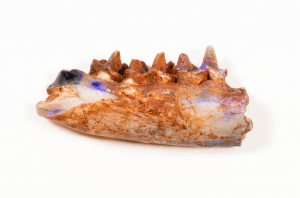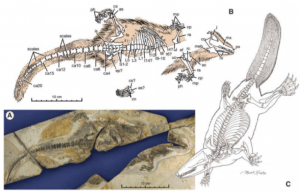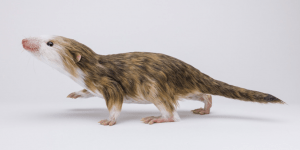Guest Author – Kim Chandler, MSc
2020 Palaeobiology Graduate
In the first part of this blog post, I discussed three early mammals that I found interesting and felt needed a bigger audience of admirers. Below is a continuation of these with four more mammals to persuade you to join team mammal.
4. Steropodon galmani
Archer, Flannery, Ritchie, & Molnar, 1985 – Late Cretaceous, Australia
It would not be right to talk about mammals without including at least one monotreme. Monotremes, often considered living fossils, retain many primitive mammalian characteristics. This famously includes egg-laying, however they also lack separate orifices for the reproductive track, anus and urinary openings (instead they have a single cloaca) and their shoulder bones are either lost or reduced. There are only three species of extant monotremes today – the platypus and echidnas. They branched off from what would become the placentals and the marsupials in the Mesozoic. Their relationship to other mammal groups was unknown for a long time, mainly due to the fact that extant adult monotremes do not have teeth, the main way fossil mammals are usually identified. The earliest known monotreme is Teinolophos, from the early Cretaceous (121-112 Ma). However, I chose the next earliest to make the list. Steropodon, which translates to “lightning tooth”, was found in Lighting ridge Australia, in an opal mine. For a while, Steropodon was Australia’s only known Mesozoic mammal. The entire bone of the fossil had been replaced with opal and it narrowly avoided being ground down for the jewellery industry. It was identified as a single right mandible with three molar teeth.
Opalization has occurred to many Australian fossils, including the dinosaurs Kakuru, Rapator and Walgettosuchus, as well as another early mammal from the same location, Kollikodon. It is thought that Steropodon had a similar lifestyle as a modern-day Platypus. This is due to the presence of a jaw feature called a mandibular canal which could be evidence of a bill.

5. Castorocauda lutrasimilis
Ji et al. 2006 – Middle Jurassic, Inner Mongolia
Castorocauda lutrasimilis, from the Upper Jurassic, has a name which translates to beaver-tail otter-like, reflecting its semi-aquatic lifestyle. Its similarities to a modern-day beaver are known due to the exquisite preservation of the holotype specimen from the Dauhugou fossil beds of Inner Mongolia. The fossil shows clear preservation of a large, flat, tail covered in scales along with strong forelimbs for swimming, flattened vertebrae and webbed feet. In addition to these features, this specimen has fossilized soft tissues and fur, making it the oldest known specimen with fossil fur (although fur is understood to have evolved far earlier in mammalian evolution). It is the largest known Jurassic mammal and is part of an extinct group known as Docodonts which have strangely shaped tooth crowns. Little was known of the skeletons of this group until the discovery of Castorocauda and the mole-like Haldanodon, previously only being known from teeth. Castorocauda’s beaver-like affinities exemplify how mammals have diversified into similar niches repeatedly over time.
Castorocauda was preserved in a 164-million-year-old fossil lake bed. These are the same fossil beds that have produced several dinosaurs, pterosaurs, amphibians and other early mammals, including the early eutherian (placental) Juramaia.

6. Sinodelphys szalayi
Luo et al. 2003 – Lower Cretaceous, China
As I have included monotremes, it would be unjust to exclude marsupials from this list. Marsupials (or metatherians) are the pouch bearing enigmatic animals such as Kangaroos, Koalas and the recently extinct thylacine (or Tasmanian tiger).
The earliest known Marsupial relative is Sinodelphys szalayi, a remarkably well-preserved fossil of the Lower Cretaceous. Unfortunately for the individual in question, the specimen is squashed flat but preserved in excellent detail with many of the features necessary for identifying it as an early marsupial relative. These features include characters of the hip bones, jaw and teeth. It also has fur and soft tissues preserved. The shape of its feet, curved claws and a long tail lead to the conclusion that it lived predominantly in the trees. At about 15cm in length and weighing approximately 30g, it would have looked much like a modern-day squirrel (or like the multituberculate Ptilodus mentioned in my previous post). Being around in the Cretaceous, this arboreal lifestyle may have been an advantage in avoiding the carnivorous dinosaurs that shared its habitat.

Sinodelphys was an important discovery in the piecing together of mammalian evolution. Remarkably, an early relative of the placental therians (Eutherians) was also discovered in the same quarry as Sinodelphys, in Liaoning Province, China. Finding these two animals at this time in the fossil record allowed scientists to place the divergence of marsupials and placentals no later than 125 million years ago. However, since the discovery of an earlier placental, Juramaia, also from Liaoning Province, this divergence has been pushed back to the Jurassic, and at least 160 mya. Sinodelphys remains the earliest known marsupial relative.
7. Morganucodon watsoni
Kühne, 1949 – Late Triassic/Early Jurassic, UK
Morganucodon watsoni is an early Jurassic mammaliaform that is considered the first true mammal. When deciding if a fossil should be classified as a mammal or not, several features are to be looked for. Modern mammals are known for having synapomorphies including possession of hair/fur, mammary glands and endothermy. However, these features do not always preserve. As such, other features are looked for – these include the jaw joint and tooth replacement. The jaw joint in mammals is ‘tempromandibular’, and the lower jaw is comprised of a single bone – the dentary. This differs to mammalian ancestors, where the jaw joint was ‘craniomandibular’ and the lower jaw was comprised of three bones – the dentary, quadrate and articular. The quadrate and the articular in mammals have migrated to the middle ear where they became the middle ear bones, the malleus and incus. This allows mammals to have sensitive hearing capabilities. Morganucodon, interestingly, shows a transitionary stage by having both the craniomandibular and temporomandibular joints. The quadrate and articular are housed in a trough in the dentary and are somehow involved in both hearing and articulation of the jaw. This shows how Morganucodon existed a stage in evolution where some ‘typical’ mammalian traits are only just appearing.
Morganucodon is also thought to be diphyodont. Diphyodonty describes the mammalian pattern of tooth replacement. In mammals, teeth are only replaced once (much like in humans, where there are a set of ‘baby’ or ‘milk’ teeth followed by replacement with adult teeth) and molars are never replaced. Morganucodon is the first in the lineage to show this, cementing its status as an early mammal (or mammaliaform as some people prefer to term it). However, research is ongoing into Morganucodon’s tooth replacement. With no older fossils showing a transitionary phase, it is possible that Morganucodon may not yet be fully diphyodont but exhibits an intermediate condition.
Thousands of specimens (mainly teeth and jaws) exist of Morganucodon watsoni, from a single fissure fill location in South Wales. As such, a lot is known about this animal due to the vast number of specimens available to researchers. Morganucodon was insectivorous, feeding mainly on beetles, and was tiny in size, less than 10 cm in length. There are lots of species of Morganucodontids, but none as well studied as M.watsoni. Morganucodon will always be my favourite fossil mammal, as diminutive as it is, as I studied it for my thesis project. Myself and my supervisors affectionately call it Morgie.

These are just some of the mammals I have decided to provide you with. There are more fossil mammals I could have discussed, and more being discovered each day. Even upon writing this, a new description has been published of a Cretaceous mammal called Adalatherium hui that shows unique features likely due to a long period of isolated evolution on the island of Madagascar.
That concludes my argument in favour of early mammals. They are often overlooked animals and rarely make an appearance in the books or tv shows that get most children entranced by dinosaurs or mammoths. It is my hope that by writing this I will raise the profile of these mammals a little higher and introduce them to people who may have overlooked them before.
Thank you for reading!
References:
Archer, M., Flannery, T.F., Ritchie, A. & Molnar, R.E (1985). First Mesozoic mammal from Australia – an early Cretaceous monotreme. Nature 318, 363-366.
Australianmuseum.net.au/learn/australia-over-time/extinct-animals/steropodon-galmani/
Ji, Q.; Luo, Z.-X.; Yuan, C.-X.; Tabrum, A. R. (2006). A swimming mammaliaform from the Middle Jurassic and ecomorphological diversification of early mammals. Science. 311 (5, 764): 1, 123–1, 127
Luo, Z.-X. (2003). An Early Cretaceous Tribosphenic Mammal and Metatherian Evolution. Science, 302(5652), 1934–1940.
Li; et al. (2001). A new family of primitive mammal from the Mesozoic of western Liaoning, China. Chinese Science Bulletin. 46 (9): 782–785
Gill, Pamela G.; Purnell, Mark A.; Crumpton, Nick; Robson-Brown, Kate; Gostling, Neil J.; Stampanoni, M.; Rayfield, Emily J. (21 August 2014). Dietary specializations and diversity in feeding ecology of the earliest stem mammals. Nature. 512 (7514): 303–305.
Krause D.W et al. (2020) Skeleton of a Cretaceous mammal from Madagascar reflects long-term insularity. Nature. Published online April 29, 2020
Further Reading:
Zofia Kielan-Jaworowska, Richard L. Cifelli, and Zhe-Xi Luo, Mammals from the Age of Dinosaurs: Origins, Evolution, and Structure, Columbia University Press, New York, 2004
Edited by Rhys Charles

